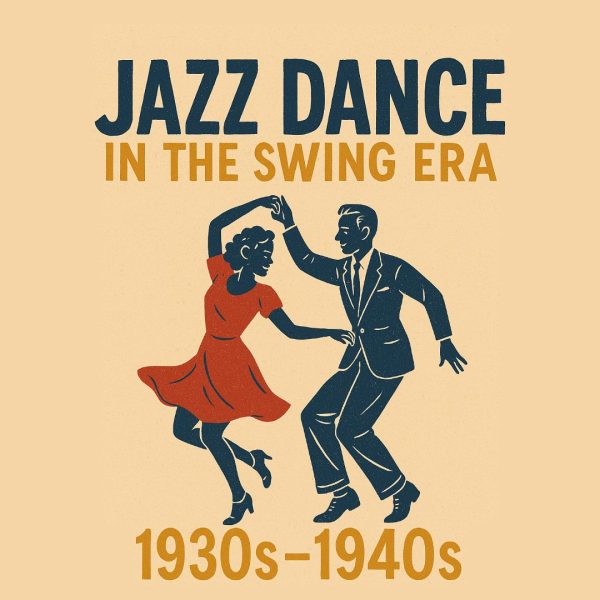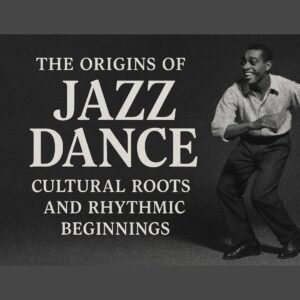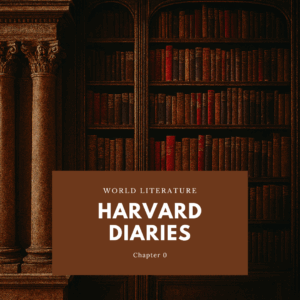
Jazz Dance Takes the Stage: From Swing to the Silver Screen
Welcome to Part Two of our five-part journey into the evolution of jazz dance. In this installment, we continue tracing the vibrant development of jazz dance from the 1930s through the 1940s—a period of transformation, innovation, and growing visibility.
In Part One, we explored the rich cultural and ethnic roots of jazz dance. Emerging from African American communities and shaped by both African and European influences, jazz dance took form as a deeply expressive and versatile art. Defined by improvisation, rhythmic complexity, and stylistic fusion, it quickly became a dynamic reflection of social and musical change.
As jazz music gained popularity, jazz dance began to move beyond community gatherings and social halls. It found new stages in theatrical productions and, eventually, on the silver screen—marking the beginning of its rise as a celebrated performance art.
Stepping into the Spotlight: Jazz Dance in the 1930s
With the rise of sound films in the 1930s, movie theaters became the new cultural epicenter, drawing in crowds and gradually overshadowing Broadway musicals. At the same time, jazz music began to evolve—moving away from ragtime, Dixieland, and blues—and embracing a more orchestrated style known as symphonic jazz. This decade became known for dance marathons, big orchestras, and the birth of swing music, all of which played a vital role in shaping jazz dance as a performance
art.
Symphonic Jazz and the Big Band Era
One of the key figures in this musical transformation was Paul Whiteman, who introduced full orchestration to jazz. His music was syncopated and featured improvisational sections, making it more danceable than earlier styles. The term “symphonic jazz” was coined during this period to
describe this new, sophisticated sound.
Other influential musicians like Duke Ellington and Louis Armstrong captivated audiences and helped define the swing era. Ellington’s famous line, “It don’t mean a thing if it ain’t got that swing,” became a cultural anthem, emphasizing rhythm and movement as central to jazz. The swing and big band era also brought forward legendary names such as Artie Shaw, Glenn Miller, Benny Goodman, Tommy and Jimmy Dorsey, and Count Basie. Swing music typically featured simple melodies with solo improvisations, creating the perfect backdrop for energetic and expressive dance styles.
Dance Styles of the Swing Era
During this time, dances like the Jitterbug, Boogie-Woogie, and especially the Lindy Hop gained popularity. The Lindy Hop, named in honor of aviator Charles Lindbergh, was a syncopated two-step or box step that included solo improvisation after the basic partner movements. Its steps and improvisational nature reflected the influence of African solo dance traditions, while also incorporating elements of European partner dancing.
One of the most iconic venues of the era was the Savoy Ballroom in Harlem, famously dubbed “The Home of Happy Feet.” Spanning an entire city block, it was the largest ballroom in the world and served as a vibrant meeting place for jazz dancers and swing musicians for over thirty years.
Hollywood Embraces Jazz Dance
In 1933, two films—42nd Street and Flying Down to Rio—featured dance as a central part of their storytelling, laying the foundation for what would become the Golden Era of dance musicals over the next two decades.
Legendary Figures of the Era
- Busby Berkeley, a visionary choreographer and producer, worked in both Broadway and Hollywood musicals. Between 1933 and 1939, he created some of the most iconic dance numbers in film history, known for their elaborate geometric patterns and synchronized movement.
- Fred Astaire, one of the most celebrated musical stars and dancers in film history, brought a spontaneous elegance to dance and song in cinema during the 1930s.
- Ginger Rogers, an American actress, dancer, and singer, became one of the most legendary figures of Hollywood’s golden age.
Together, Astaire and Rogers formed one of the most iconic dance duos in film history. Starring in numerous musical films, they became symbols of grace, charm, and escapism during the Great Depression, offering audiences a romantic and joyful escape from everyday life.
From Film to Stage: The 1930s Dance Musicals
The 1930s saw the rise of dance in film, with musicals becoming a major form of entertainment.
Here is a list of iconic films from that era where dance played a central role:
1930s Dance Film Highlights:
- 42nd Street (1933)
- Flying Down to Rio (1933)
- Gold Diggers (1933)
- Roberta (1935)
- Top Hat (1935)
- Follow the Fleet (1936)
- Swing Time (1936)
- Shall We Dance (1937)
- Carefree (1938)
- The Story of Vernon and Irene Castle (1939)
These films laid the groundwork for what would become the Golden Era of dance musicals, blending storytelling with choreography and elevating jazz dance to a new level of visibility and artistry.
Jazz Dance in the Spotlight: Professionalism, Broadway, and the 1940s Film Era
The 1940s marked a turning point in jazz dance history. It was during this decade that jazz dance began to professionalize, influenced heavily by ballet and modern dance. By combining classical ballet technique with the natural expressiveness of modern dance, jazz gained a sophisticated and artistic quality.
This was the era when jazz dance, as we know it today, began to appear on Broadway stages, performed by professionally trained dancers. In musicals like On the Town (1944) and ballets such as Fancy Free (1944), choreographer Jerome Robbins introduced a freer, more rhythmic style of movement—what we now recognize as jazz dance.
The Rise of Jazz Dance Technique
As jazz dance became more prominent in theater and film, the need for a formal technique grew. One of the most influential figures in this development was Jack Cole, often referred to as the. Father of Jazz Technique. A trained modern dancer, Cole developed an innovative style and training method that emphasized body isolation and natural movement. His work laid the foundation for generations of jazz dancers and choreographers.
During this time, Afro-Haitian, West Indian, and Latin dance forms also fused with jazz, rejuvenating its earthy and primitive roots and emphasizing drumming as a primary musical source.
Key Figures and Films of the 1940s
- Agnes de Mille, choreographer of Oklahoma! (1943), revolutionized musical comedy by making dance a central storytelling element.
- Jerome Robbins, American choreographer and director, blended ballet and jazz into theatrical masterpieces.
- A new wave of dance stars emerged, celebrated for their skill and charisma:
Betty Grable, June Allyson, Dan Dailey, Mickey Rooney, Shirley Temple, Judy Garland, James Cagney, Rita Hayworth, and Jack Cole. - Gene Kelly began his musical career in the early 1940s and quickly became one of the brightest stars of the genre. Known for his athletic and energetic style, Kelly brought a fresh dynamism to jazz dance on screen.
1940s Dance Film Highlights:
- Oklahoma! (1943)
- Anchors Aweigh (1945)
- Ziegfeld Follies (1946)
- On the Town (1949)
Closing thoughts
The 1940s marked a transformative era for jazz dance—one where it matured into a professional art form and found its place on both Broadway stages and Hollywood screens. Influenced by ballet, modern dance, and global rhythms, jazz dance evolved into a sophisticated and expressive style, shaped by visionary choreographers and charismatic performers. As musicals became cultural landmarks, jazz dance not only entertained but also reflected the spirit of its time—resilient, innovative, and full of life. In the next part of this series, we’ll explore how jazz dance continued to evolve through the 1950s and beyond, with new icons, techniques, and cultural shifts that kept its rhythm alive.


